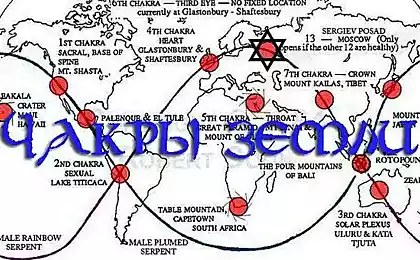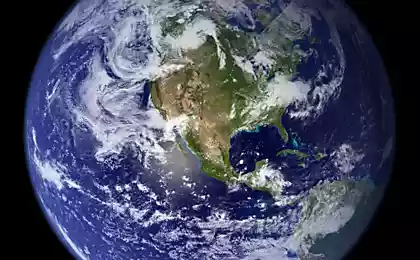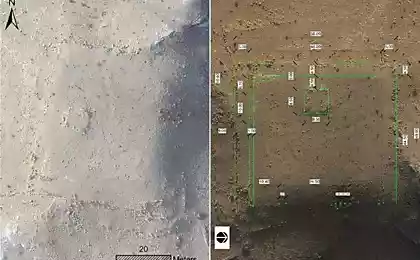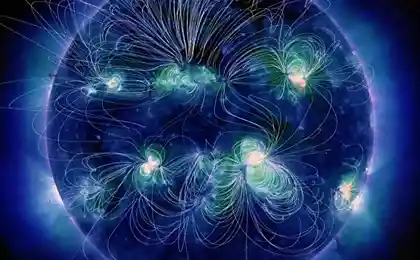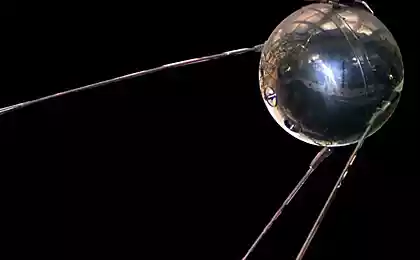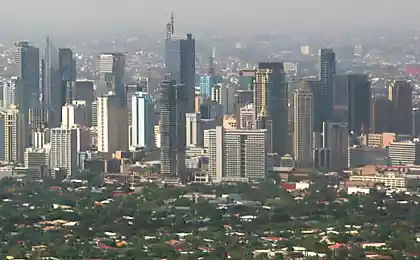920
Satellite photos of the earth (23 leads)
1) In April 2001, the Moderate Resolution Imaging Spectroradiometer MODIS, mounted on the Terra satellite agency NASA, photographed circling dust storm over China. Steadily gaining momentum over China cyclone spins counterclockwise, moving, so the wall of dust. The thick, yellowish-brown dust so dense that not only hides the surface of the earth, and almost constitutes its own terrain, lifting the clouds of dust ridges. The width of the spiral arms of white clouds is about 200 km. (NASA / Jesse Allen, Robert Simmon / MODIS science team)
via
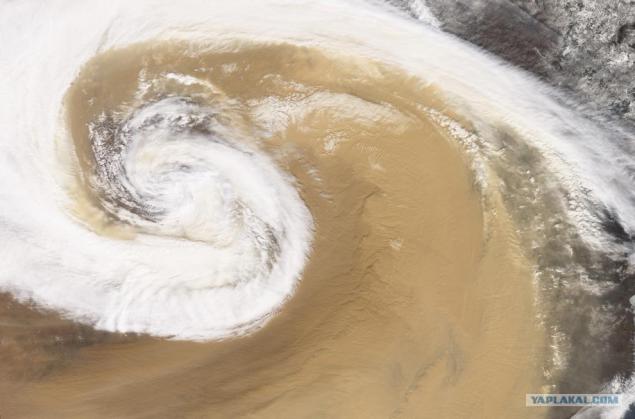
2) The picture Bear Glacier Kenai Peninsula, Gulf of Alaska made August 8, 2005 from the satellite IKONOS. In this image shows the region leaching, where the glacier begins to melt. Climb up the hill foot of the glacier riddled with crevasses - cracks in the ice, appeared from behind the movement of the glacier on uneven surfaces. Toward the middle of the glacier begins dark gray stripes. As the movement of the glacier, they are filled with mud and boulders. When the two glaciers converge, as in our case, the dirt and debris are forced out onto the surface of parallel strips or median sediment. (Picture from satellite IKONOS GeoEye)
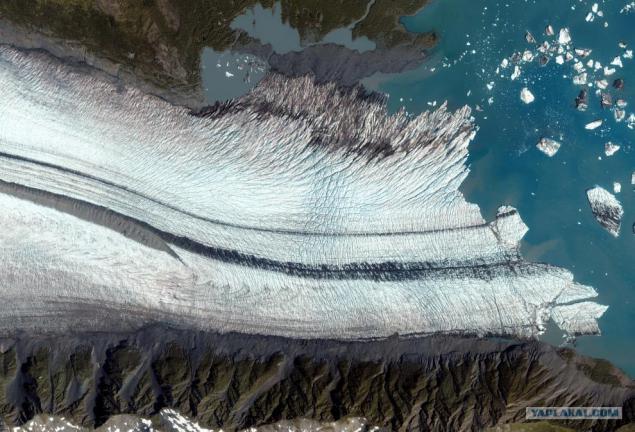
3) south of Khartoum, Sudan - a place where it joins the Nile and the Blue Nile, and the dizzying systematization of irrigation runs through the entire state. Several small "bare" areas of land - a villa. This picture was taken using a system of Advanced Spaceborne Thermal Emission and Reflection Radiometer (ASTER) satellite NASA's Terra December 25, 2006. (NASA / GSFC / METI / ERSDAC / JAROS, US / Japan ASTER Science Team)
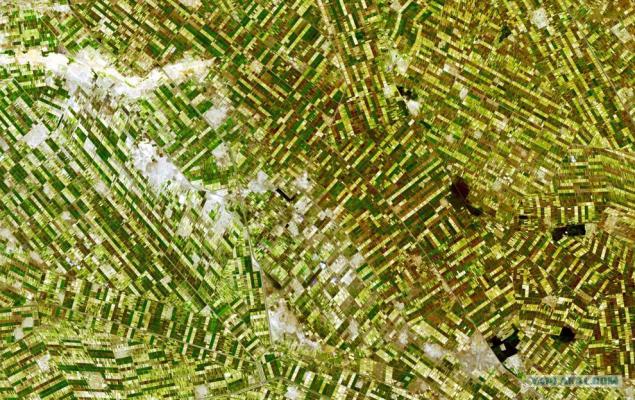
4) This crater is deep in the Sahara desert. With the shape of almost perfect circle, its width is 1.9 kilometers (1.2 miles), and the height of the outside edge - 100 meters (330futov). This crater is located on a vast plane of rock, formed over hundreds of millions of years before the first dinosaurs on Earth. Modern geologists long debated about the causes of this crater, some of them are inclined to the idea of a volcanic crater formation. However, a more detailed study of the structure, you may find that the fossil "lava" - in fact the mountain melted by the impact of a meteorite on Earth. System ASTER, mounted on NASA's Terra satellite took a picture of the crater Tenoumer in Mauritania January 24, 2008. (NASA, Jesse Allen, NASA / GSFC / METI / ERSDAC / JAROS, US / Japan ASTER Science Team)
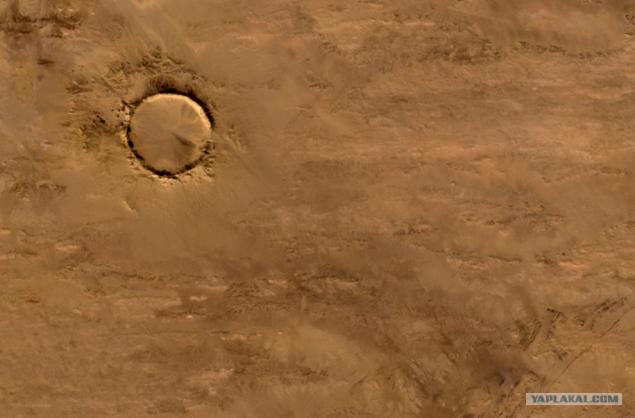
5) In the middle of December 2008 the cloudless sky made it possible to make a clear picture of Tibet. December 18, 2008 System MODIS, located on board the Terra satellite agency NASA, took this picture in natural colors. Snow caps some mountain peaks and partially ice-covered lakes in this mountainous region, called "Roof of the World» (NASA / Jeff Schmaltz, MODIS Rapid Response Team, Goddard Space Flight Center)
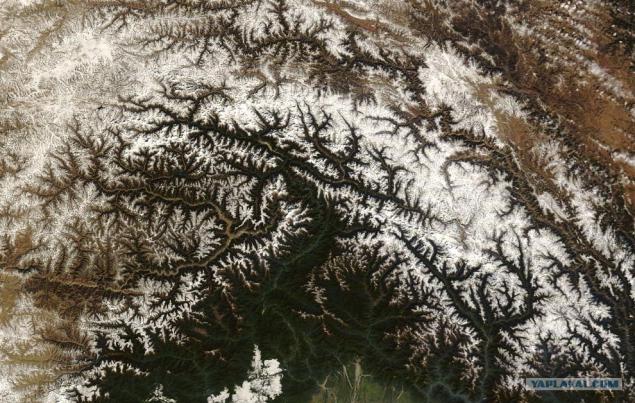
6) December 13, 1999, through a system of Enhanced Mapper to the Classification of geological regions Plus (ETM +), installed on the Landsat 7 satellite agency NASA, the picture was taken of the National Park Sidi Toui, located in the southern part of Tunisia, near the Libyan border. On the territory of this protected park (about the width of about 7 km.), You can see the natural vegetation. The park was founded in 1993 for the prevention of desertification in the region. Effects of continuous cropping, overgrazing and drought can be estimated by looking at the surrounding park badlands. (NASA / Jesse Allen / Landsat, USGS)
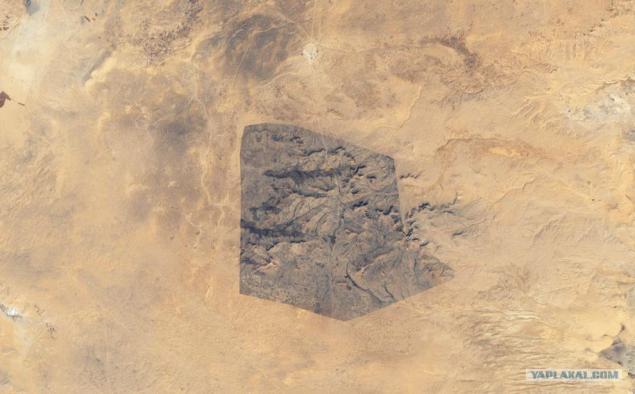
7) The photograph shows two cyclones which have formed a tandem in November 2006. This image of two cyclones south of Iceland, has been made the system (MODIS) NASA's Terra satellite on November 20 (the image is South top) (NASA / Jesse Allen, Earth Observatory)
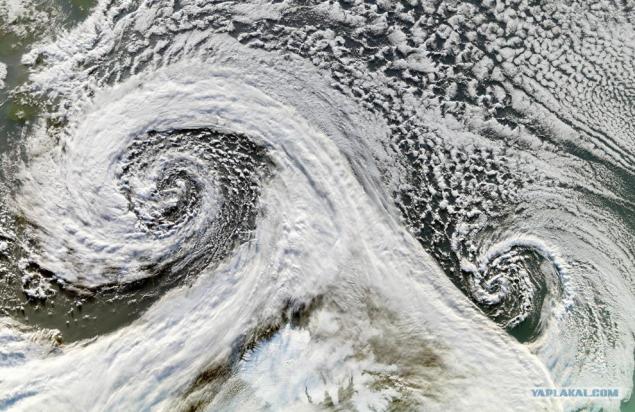
8) Even in the snow-covered ground in the world there are areas uncovered by snow. In Antarctica between the Ross Sea and East Antarctic ice sheet is parallel group ranging valleys. Known as the Dry Valleys (Dry Valley), they almost continually blown downward winds - cold, dry air, rushing down to the sea from the hills of the ice sheet. Refuge in the Dry Valleys - accumulation of glaciers and ice-covered lake. This picture was taken spectrozonal system of NASA's ASTER satellite Terra, 29 November 2000. (NASA / Jesse Allen, NASA / GSFC / METI / ERSDAC / JAROS, US / Japan ASTER Science Team)
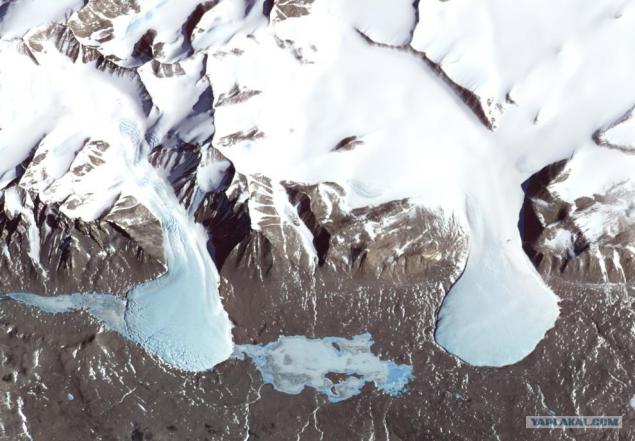
9) About 480 to 320 kilometers, Dasht-e Lut - large salt desert in southeastern Iran. In this photo, taken in natural colors system ASTER NASA's Terra satellite May 13, 2006, see the section of the south-eastern part of the Dasht-e Lut. This area of sand, and here are some of the world's highest sand dunes, some of which reach a height of 300 meters (1000 feet) (NASA / Jesse Allen, Earth Observatory, NASA / GSFC / MITI / ERSDAC / JAROS, US / Japan ASTER Science Team)
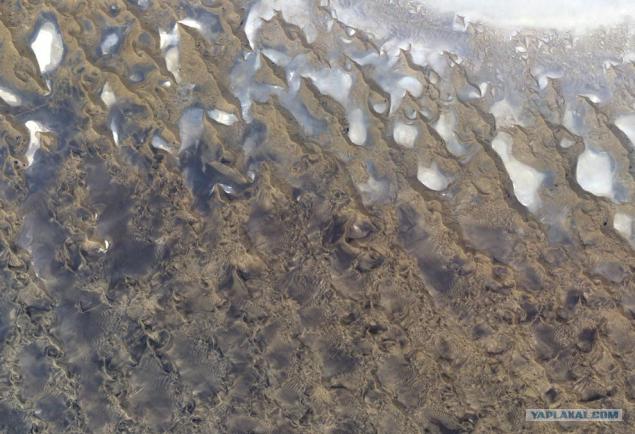
10) During the last ice age, the Canadian island Akimiski was buried under the ice with a thickness of several hundred meters, but from the moment moved the ice, the island began to climb (elevation elevation), and new beach areas have formed rivers and lakes, and trees and other vegetation began to grow in new areas. This image was made island Akimiski Landsat 7 satellite on Aug. 9, 2000. (NASA / Jesse Allen, Landsat, University of Maryland's Global Land Cover Facility)
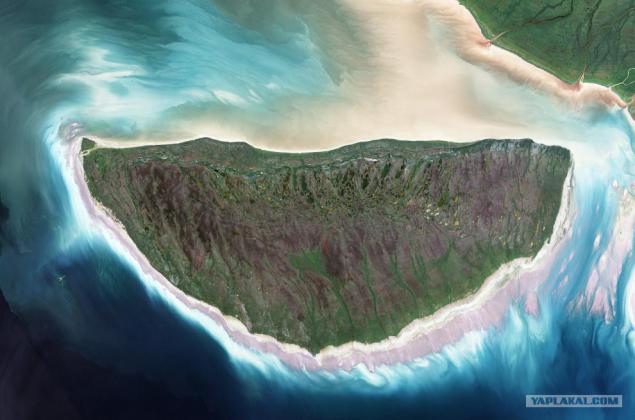
11) exorbitant Antarctic mountains direct the flow of the ice sheet in a fast-moving icy river named Byrd Glacier, located near the station McMurdo - main Antarctic research station of the United States. Glacier rushes in the Transatlantic Mountains in deep, 15-meter wide channel, creating a flow of ice Crushing stones, stretching 100 miles. This picture taken 24 years dekabrya1999 Landsat 7 satellite, shows a portion of the current through the Transatlantic Mountains icy river Byrd Glacier (Jesse Allen, Landsat Image Mosaic of Antarctica, LIMA)
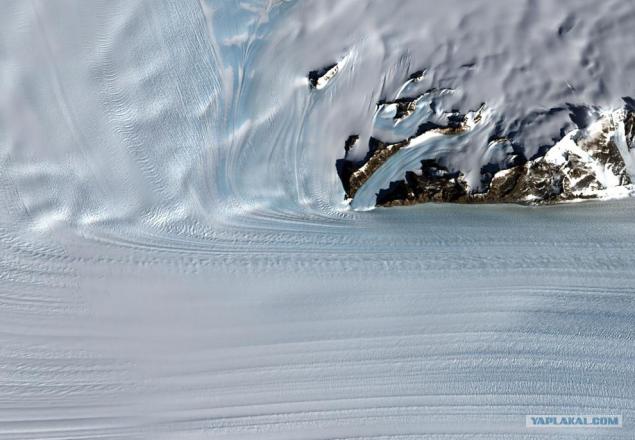
12) The world's largest sand sea, located in the Arabian Peninsula - Empty Quarter, or also known as Rub 'al Khali (Rub Al Khali), accommodates approximately one and a half times more sand than the Sahara Desert. Empty Quarter area of 583, 000 square kilometers (225 000 square miles) and stretches it in the area between Saudi Arabia, Yemen, Oman and the United Arab Emirates. System ETM, installed on the Landsat 7 satellite agency NASA, took this picture August 26, 2001. (NASA / Robert Simmon, Landsat, USGS)
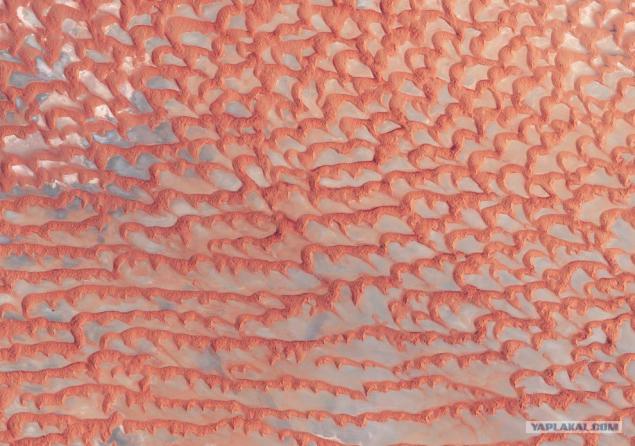
13) In mid-December 2005, a tiny island Amsterdam Let the waves, but not in the Indian Ocean, where it is peculiar to observe, but right in the clouds overhead. System MODIS, located on board the Terra satellite agency NASA, December 19 of 2005 recorded the action. By itself, the island is too small to see him in the picture, but it serves as a starting point clouds that sail further to the northeast in the form of a huge letter V. (NASA / Jeff Schmaltz, MODIS Land Rapid Response Team at NASA GSFC)
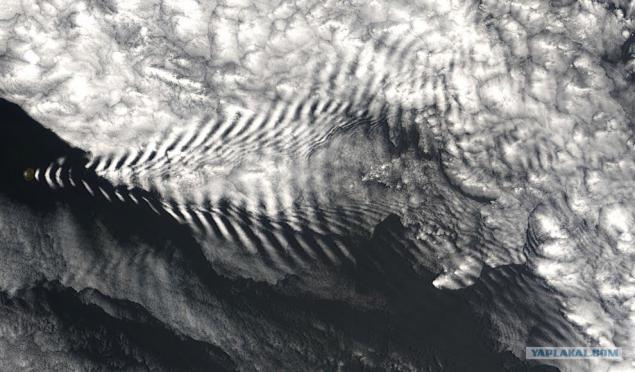
14) In this very detailed images of the March 8, 2008 made with Taiwanese satellite Formosat-2 displayed different in size and shape pieces of the wreckage of the ice shelf of the Antarctic Peninsula. Several large icebergs float among a mosaic of small fragments of ice. The degree of image detail is so good that it may seem as if you are standing on a scale model made of papier-mâché and foam blocks. This level of detail can create a deceptive impression of authenticity sized icebergs. In fact, some of the larger icebergs reach a length of several hundred meters (yards) (Formosat image © 2008 Dr. Cheng-Chien Liu, National Cheng-Kung University and Dr. An-Ming Wu, National Space Organization, Taiwan)
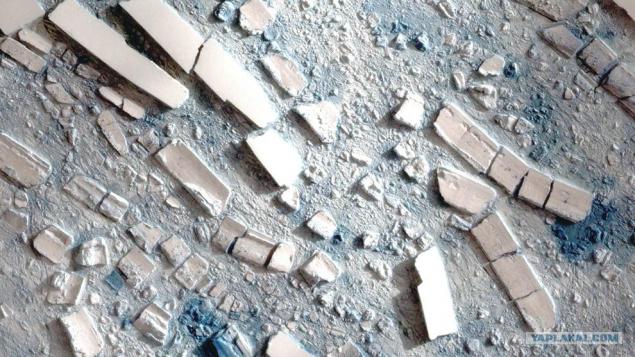
15) This is a snapshot of the southeastern province of Fars in southern Iran, made in faux-natural colors, displays riverbed cuts through the north-east through the arid land of mountains. A wide strip of land, lush agricultural land follows the curve of the dry delta and spreads along the road that runs parallel to the ridge. The border region of the valley of bright green agricultural area smoothly into the pale green (or irrigation canals). The picture was taken with the system ASTER NASA's Terra satellite on Oct. 12, 2004 (NASA / Jesse Allen, NASA / GSFC / METI / ERSDAC / JAROS, US / Japan ASTER Science Team)
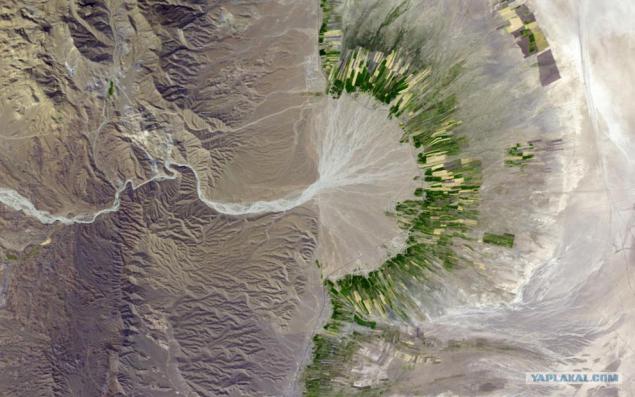
16) Tropical Cyclone Billy, struck the west coast of Australia on 25 December 2008, the system captured MODIS, installed on the Aqua satellite agency NASA (NASA / Jeff Schmaltz, MODIS Rapid Response Team, Goddard Space Flight Center)
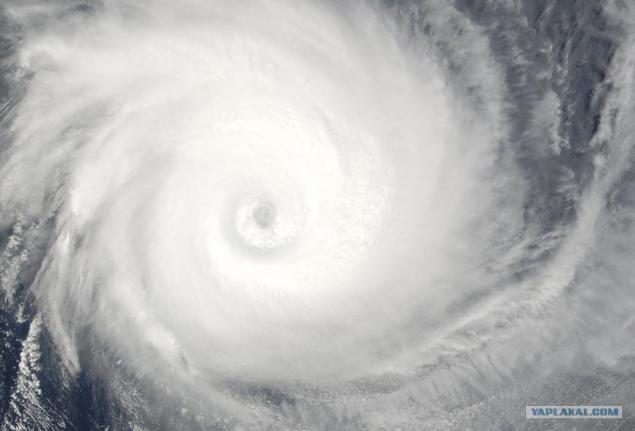
17) In this photo from June 4, 2008 can be seen the colorful blooms of phytoplankton across the Black Sea, along the southern coast, near the Turkish city of Sinop (Sinop) and Samsun (Samsun). Photography, the natural color, the system was made MODIS, installed on the Aqua satellite agency NASA. (NASA / MODIS Rapid Response Team)
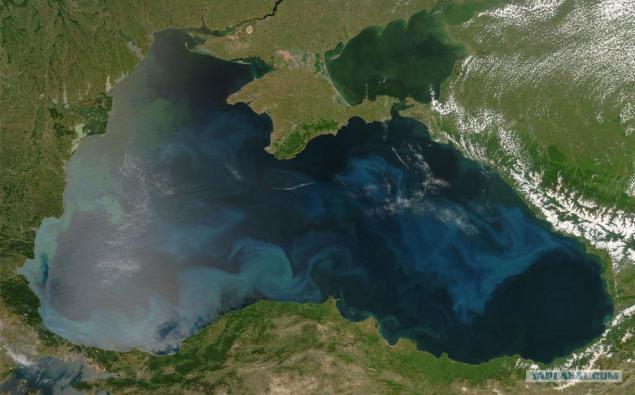
18) This picture of the forest in the north of the Republic of the Congo was made June 27, 2002 commercial satellite Ikonos. At the center of the photo cross dirt logging roads (orange lines). This image - one of hundreds of images taken by a commercial satellite and the satellite agency NASA, used by scientists Research Center «Woods Hole» to create a map of the location of forest roads and logging in an area of 4 million square kilometers of tropical African forests on 3 decades of the coming of 2003 (NASA / Jesse Allen, IKONOS, Nadine Laporte, Woods Hole Research Center)
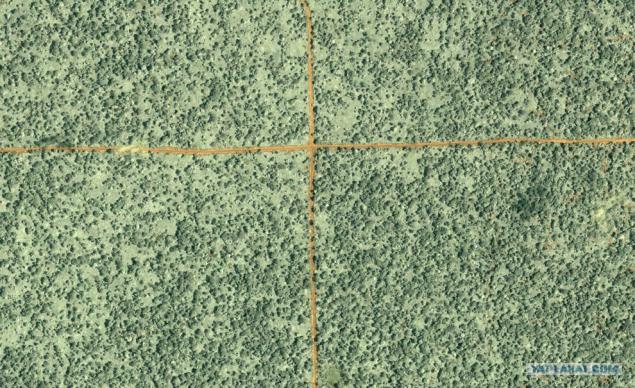
19) Mount Harrat Khaybar in Saudi Arabia contains many types of volcanic rock and the impressive relief of the crust. Some of them are shown in this photograph, taken by astronauts from the International Space Station March 31, 2008. Jabal («mountain" in Arabic) al Qidr formed from lava flows of liquid of dark basalt few eruptions. Jabal Abyad, in the center of the image, was formed from the thicker lava rich in quartz, also called rhyolite. (NASA-JSC)
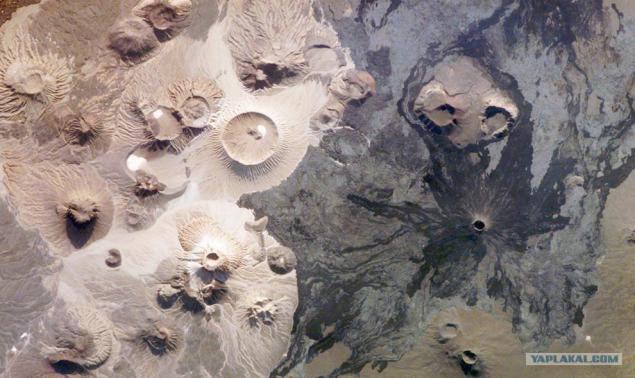
20) The picture is two-ton plume of dust, driven by the north coast of Libya on Oct. 26, 2007, made the system MODIS, installed on the Terra satellite agency NASA. Despite the fact that the trail on the west side of beige and resembles sands of the Sahara, the eastern side of it is noticeably darker. (NASA / Jeff Schmaltz, MODIS Rapid Response Team, NASA-Goddard Space Flight Center)
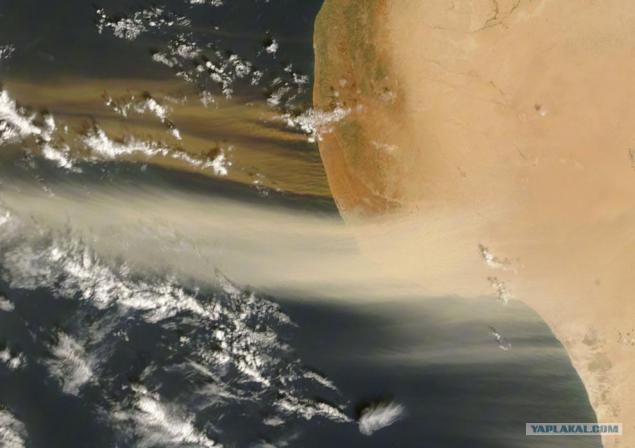
21) May 18, 1980, during the eruption of the volcano of San Gelens (Mount St. Helens), north side collapsed, and a massive flow of stone, mud and volcanic debris swept down the mountain. This picture taken 28 October 2008 astronaut to the International Space Station, showing us the scene nearly three decades after the eruption - is still visible damage caused by afforestation in an avalanche. On the south side of the mountain landscape covered with dense green forest, while the north side of the vegetation is rare, especially at high altitudes. (NASA / JSC)
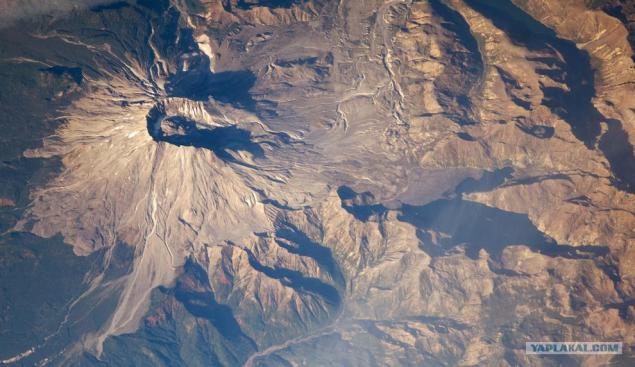
22) In this photo taken in September 2004 with a commercial satellite IKONOS, houses and streets hectic Las Vegas, Nevada. (satellite IKONOS © 2004 GeoEye)

23) In this photograph taken by an astronaut 2008goda August 19, in the Amazon flood plains and numerous lakes is reflected glitter rays of the setting sun. There captured about 150 kilometers of the Amazon, at a distance of about 1,000 kilometers inland from the Atlantic Ocean. This shot was caught by the crew of Expedition 17 International Space Station August 19 2008goda. (NASA / JSC)

Source:
via

2) The picture Bear Glacier Kenai Peninsula, Gulf of Alaska made August 8, 2005 from the satellite IKONOS. In this image shows the region leaching, where the glacier begins to melt. Climb up the hill foot of the glacier riddled with crevasses - cracks in the ice, appeared from behind the movement of the glacier on uneven surfaces. Toward the middle of the glacier begins dark gray stripes. As the movement of the glacier, they are filled with mud and boulders. When the two glaciers converge, as in our case, the dirt and debris are forced out onto the surface of parallel strips or median sediment. (Picture from satellite IKONOS GeoEye)

3) south of Khartoum, Sudan - a place where it joins the Nile and the Blue Nile, and the dizzying systematization of irrigation runs through the entire state. Several small "bare" areas of land - a villa. This picture was taken using a system of Advanced Spaceborne Thermal Emission and Reflection Radiometer (ASTER) satellite NASA's Terra December 25, 2006. (NASA / GSFC / METI / ERSDAC / JAROS, US / Japan ASTER Science Team)

4) This crater is deep in the Sahara desert. With the shape of almost perfect circle, its width is 1.9 kilometers (1.2 miles), and the height of the outside edge - 100 meters (330futov). This crater is located on a vast plane of rock, formed over hundreds of millions of years before the first dinosaurs on Earth. Modern geologists long debated about the causes of this crater, some of them are inclined to the idea of a volcanic crater formation. However, a more detailed study of the structure, you may find that the fossil "lava" - in fact the mountain melted by the impact of a meteorite on Earth. System ASTER, mounted on NASA's Terra satellite took a picture of the crater Tenoumer in Mauritania January 24, 2008. (NASA, Jesse Allen, NASA / GSFC / METI / ERSDAC / JAROS, US / Japan ASTER Science Team)

5) In the middle of December 2008 the cloudless sky made it possible to make a clear picture of Tibet. December 18, 2008 System MODIS, located on board the Terra satellite agency NASA, took this picture in natural colors. Snow caps some mountain peaks and partially ice-covered lakes in this mountainous region, called "Roof of the World» (NASA / Jeff Schmaltz, MODIS Rapid Response Team, Goddard Space Flight Center)

6) December 13, 1999, through a system of Enhanced Mapper to the Classification of geological regions Plus (ETM +), installed on the Landsat 7 satellite agency NASA, the picture was taken of the National Park Sidi Toui, located in the southern part of Tunisia, near the Libyan border. On the territory of this protected park (about the width of about 7 km.), You can see the natural vegetation. The park was founded in 1993 for the prevention of desertification in the region. Effects of continuous cropping, overgrazing and drought can be estimated by looking at the surrounding park badlands. (NASA / Jesse Allen / Landsat, USGS)

7) The photograph shows two cyclones which have formed a tandem in November 2006. This image of two cyclones south of Iceland, has been made the system (MODIS) NASA's Terra satellite on November 20 (the image is South top) (NASA / Jesse Allen, Earth Observatory)

8) Even in the snow-covered ground in the world there are areas uncovered by snow. In Antarctica between the Ross Sea and East Antarctic ice sheet is parallel group ranging valleys. Known as the Dry Valleys (Dry Valley), they almost continually blown downward winds - cold, dry air, rushing down to the sea from the hills of the ice sheet. Refuge in the Dry Valleys - accumulation of glaciers and ice-covered lake. This picture was taken spectrozonal system of NASA's ASTER satellite Terra, 29 November 2000. (NASA / Jesse Allen, NASA / GSFC / METI / ERSDAC / JAROS, US / Japan ASTER Science Team)

9) About 480 to 320 kilometers, Dasht-e Lut - large salt desert in southeastern Iran. In this photo, taken in natural colors system ASTER NASA's Terra satellite May 13, 2006, see the section of the south-eastern part of the Dasht-e Lut. This area of sand, and here are some of the world's highest sand dunes, some of which reach a height of 300 meters (1000 feet) (NASA / Jesse Allen, Earth Observatory, NASA / GSFC / MITI / ERSDAC / JAROS, US / Japan ASTER Science Team)

10) During the last ice age, the Canadian island Akimiski was buried under the ice with a thickness of several hundred meters, but from the moment moved the ice, the island began to climb (elevation elevation), and new beach areas have formed rivers and lakes, and trees and other vegetation began to grow in new areas. This image was made island Akimiski Landsat 7 satellite on Aug. 9, 2000. (NASA / Jesse Allen, Landsat, University of Maryland's Global Land Cover Facility)

11) exorbitant Antarctic mountains direct the flow of the ice sheet in a fast-moving icy river named Byrd Glacier, located near the station McMurdo - main Antarctic research station of the United States. Glacier rushes in the Transatlantic Mountains in deep, 15-meter wide channel, creating a flow of ice Crushing stones, stretching 100 miles. This picture taken 24 years dekabrya1999 Landsat 7 satellite, shows a portion of the current through the Transatlantic Mountains icy river Byrd Glacier (Jesse Allen, Landsat Image Mosaic of Antarctica, LIMA)

12) The world's largest sand sea, located in the Arabian Peninsula - Empty Quarter, or also known as Rub 'al Khali (Rub Al Khali), accommodates approximately one and a half times more sand than the Sahara Desert. Empty Quarter area of 583, 000 square kilometers (225 000 square miles) and stretches it in the area between Saudi Arabia, Yemen, Oman and the United Arab Emirates. System ETM, installed on the Landsat 7 satellite agency NASA, took this picture August 26, 2001. (NASA / Robert Simmon, Landsat, USGS)

13) In mid-December 2005, a tiny island Amsterdam Let the waves, but not in the Indian Ocean, where it is peculiar to observe, but right in the clouds overhead. System MODIS, located on board the Terra satellite agency NASA, December 19 of 2005 recorded the action. By itself, the island is too small to see him in the picture, but it serves as a starting point clouds that sail further to the northeast in the form of a huge letter V. (NASA / Jeff Schmaltz, MODIS Land Rapid Response Team at NASA GSFC)

14) In this very detailed images of the March 8, 2008 made with Taiwanese satellite Formosat-2 displayed different in size and shape pieces of the wreckage of the ice shelf of the Antarctic Peninsula. Several large icebergs float among a mosaic of small fragments of ice. The degree of image detail is so good that it may seem as if you are standing on a scale model made of papier-mâché and foam blocks. This level of detail can create a deceptive impression of authenticity sized icebergs. In fact, some of the larger icebergs reach a length of several hundred meters (yards) (Formosat image © 2008 Dr. Cheng-Chien Liu, National Cheng-Kung University and Dr. An-Ming Wu, National Space Organization, Taiwan)

15) This is a snapshot of the southeastern province of Fars in southern Iran, made in faux-natural colors, displays riverbed cuts through the north-east through the arid land of mountains. A wide strip of land, lush agricultural land follows the curve of the dry delta and spreads along the road that runs parallel to the ridge. The border region of the valley of bright green agricultural area smoothly into the pale green (or irrigation canals). The picture was taken with the system ASTER NASA's Terra satellite on Oct. 12, 2004 (NASA / Jesse Allen, NASA / GSFC / METI / ERSDAC / JAROS, US / Japan ASTER Science Team)

16) Tropical Cyclone Billy, struck the west coast of Australia on 25 December 2008, the system captured MODIS, installed on the Aqua satellite agency NASA (NASA / Jeff Schmaltz, MODIS Rapid Response Team, Goddard Space Flight Center)

17) In this photo from June 4, 2008 can be seen the colorful blooms of phytoplankton across the Black Sea, along the southern coast, near the Turkish city of Sinop (Sinop) and Samsun (Samsun). Photography, the natural color, the system was made MODIS, installed on the Aqua satellite agency NASA. (NASA / MODIS Rapid Response Team)

18) This picture of the forest in the north of the Republic of the Congo was made June 27, 2002 commercial satellite Ikonos. At the center of the photo cross dirt logging roads (orange lines). This image - one of hundreds of images taken by a commercial satellite and the satellite agency NASA, used by scientists Research Center «Woods Hole» to create a map of the location of forest roads and logging in an area of 4 million square kilometers of tropical African forests on 3 decades of the coming of 2003 (NASA / Jesse Allen, IKONOS, Nadine Laporte, Woods Hole Research Center)

19) Mount Harrat Khaybar in Saudi Arabia contains many types of volcanic rock and the impressive relief of the crust. Some of them are shown in this photograph, taken by astronauts from the International Space Station March 31, 2008. Jabal («mountain" in Arabic) al Qidr formed from lava flows of liquid of dark basalt few eruptions. Jabal Abyad, in the center of the image, was formed from the thicker lava rich in quartz, also called rhyolite. (NASA-JSC)

20) The picture is two-ton plume of dust, driven by the north coast of Libya on Oct. 26, 2007, made the system MODIS, installed on the Terra satellite agency NASA. Despite the fact that the trail on the west side of beige and resembles sands of the Sahara, the eastern side of it is noticeably darker. (NASA / Jeff Schmaltz, MODIS Rapid Response Team, NASA-Goddard Space Flight Center)

21) May 18, 1980, during the eruption of the volcano of San Gelens (Mount St. Helens), north side collapsed, and a massive flow of stone, mud and volcanic debris swept down the mountain. This picture taken 28 October 2008 astronaut to the International Space Station, showing us the scene nearly three decades after the eruption - is still visible damage caused by afforestation in an avalanche. On the south side of the mountain landscape covered with dense green forest, while the north side of the vegetation is rare, especially at high altitudes. (NASA / JSC)

22) In this photo taken in September 2004 with a commercial satellite IKONOS, houses and streets hectic Las Vegas, Nevada. (satellite IKONOS © 2004 GeoEye)

23) In this photograph taken by an astronaut 2008goda August 19, in the Amazon flood plains and numerous lakes is reflected glitter rays of the setting sun. There captured about 150 kilometers of the Amazon, at a distance of about 1,000 kilometers inland from the Atlantic Ocean. This shot was caught by the crew of Expedition 17 International Space Station August 19 2008goda. (NASA / JSC)

Source:

